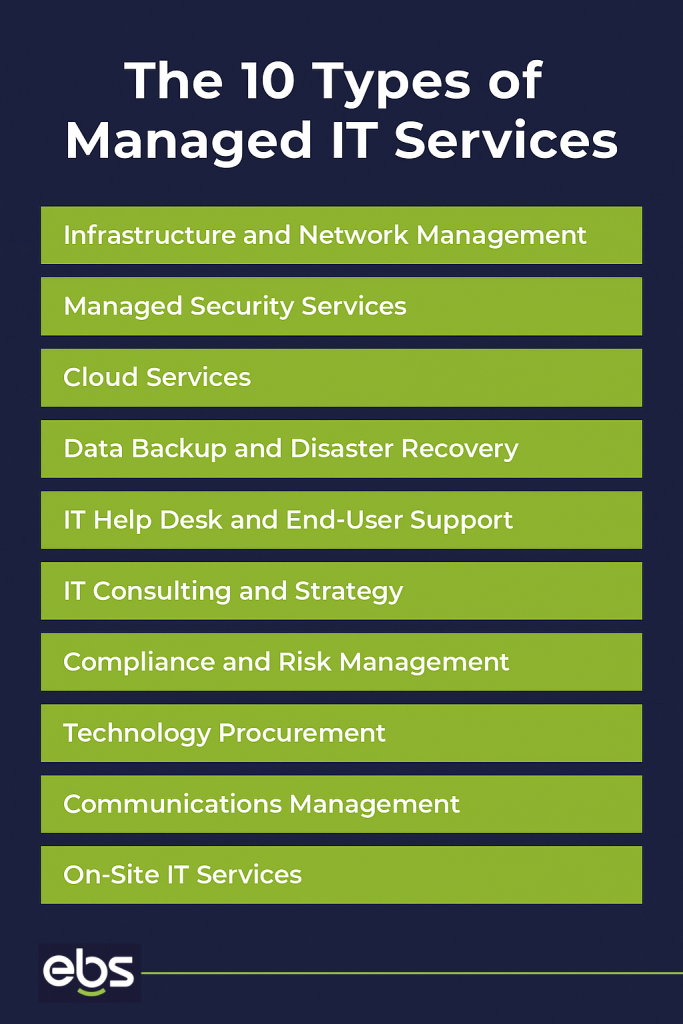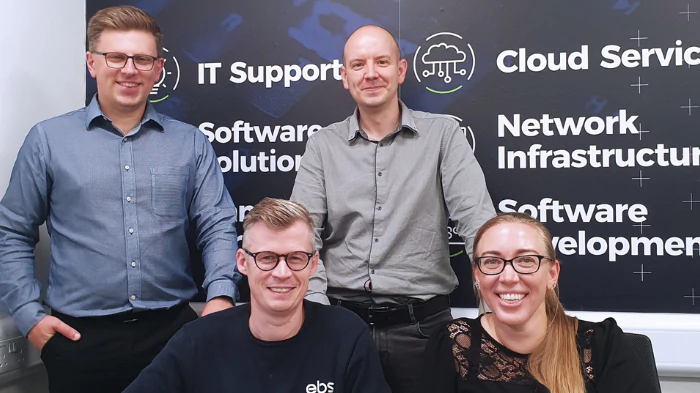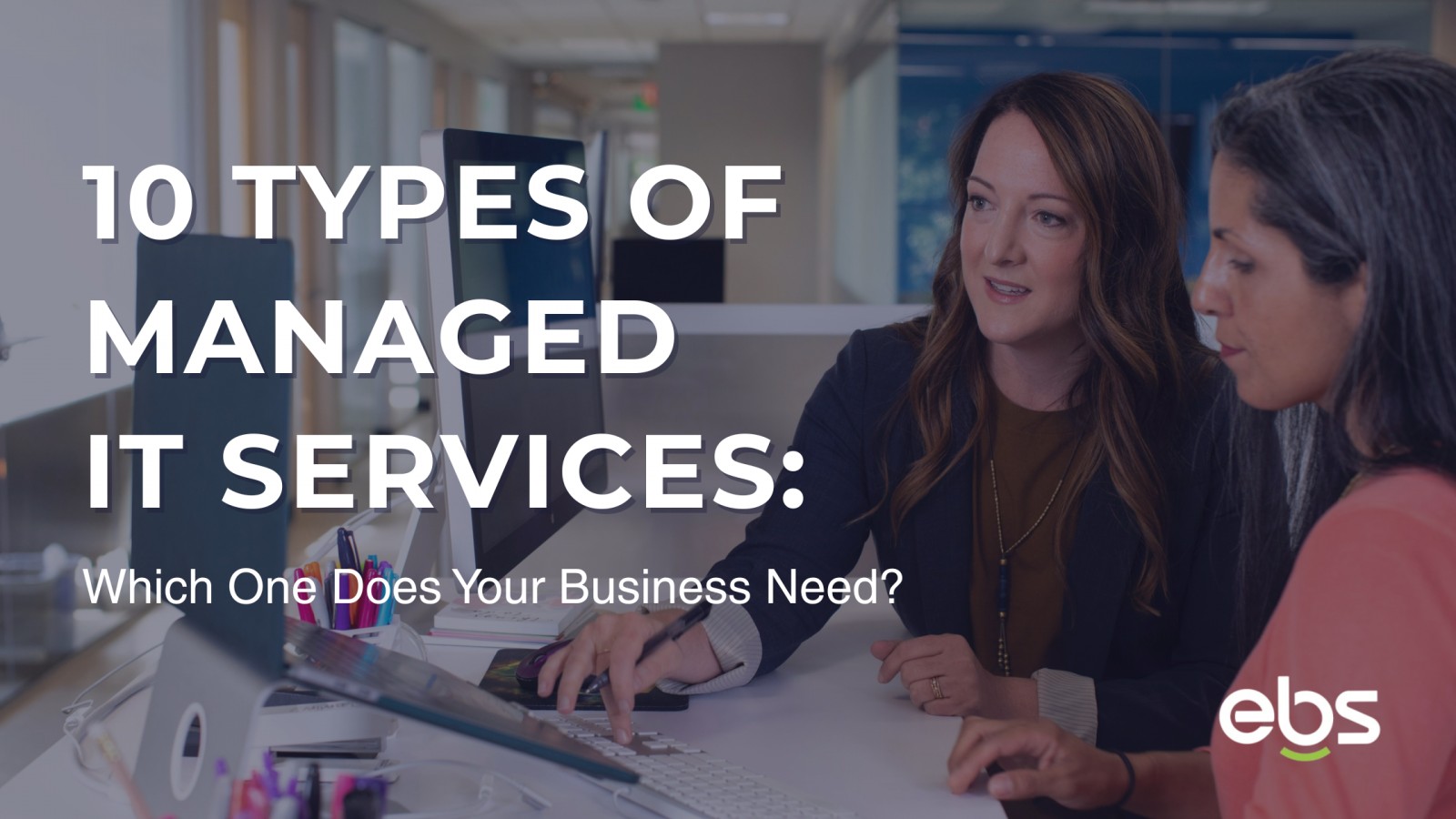Posted on 3rd June 2025
Looking to understand the different types of managed services – and which ones actually make sense for your business? You’re in the right place.
In this guide, we break down 10 core types of managed services, explaining what each one covers, who it’s best suited to, and how it could support your business more effectively. With decades of experience helping businesses get more from their IT, we know what works and how the right services can drive real value at EBS.
What Are Managed IT Services?
Managed IT services involve outsourcing the ongoing management and support of your IT systems to a trusted third party – known as a Managed Service Provider (MSP). Rather than relying on in-house resources or calling for help only when something breaks, you get proactive support and efficient management that keeps your technology running smoothly day in, day out.
Related article: What Are Managed IT Services?

10 Types of Managed IT Services
Here’s a close look at the ten core services most commonly provided by MSPs – starting with your network’s foundation.
1. Infrastructure and Network Management
You might have heard of infrastructure and network management before, but what does it involve? In short, it’s the continuous monitoring, maintenance, and optimisation of your IT environment – including servers, routers, switches, firewalls, and wireless networks.
This type of service includes regular checks to make sure everything’s working properly, fixing small issues before they turn into bigger problems, and helping your setup run as quickly and reliably as possible. It’s a behind-the-scenes service that makes a big difference to everyday working life and operational efficiency.
2. Managed Security Services
Managed cyber security can either be included as part of your broader managed IT services or provided as an add-on – so it’s essential to make sure you’ve got it covered.
Why does it matter? According to government figures, 50% of businesses identified a cyber crime last year – and of those, 44% were successfully targeted. In other words, you could either be in the half that avoided serious impact… or the half that didn’t. The right protection makes all the difference.
Typical features include:
- Firewalls to control incoming and outgoing traffic and block unauthorised access.
- Antivirus and anti-malware software to detect and remove harmful files.
- Endpoint protection to secure laptops, phones, and other devices, whether they’re in the office or being used remotely.
- Email filtering to reduce spam and stop phishing attempts before they reach users.
- Proactive monitoring and response to flag unusual activity and respond quickly to potential issues.
- Regular patching and software updates to fix vulnerabilities and keep your systems up to date.
- Staff training to help your team recognise threats and take the right steps to stay secure.
- Virtual Private Networks (VPNs) to create secure, encrypted connections for remote workers.
3. Cloud Services
Put simply, the cloud is about storing and accessing your data, systems, and software over the internet instead of relying on local servers or office-based infrastructure. It gives your team the flexibility to work from anywhere, strengthens your security, and makes it easier to adapt as your business evolves.
Managed cloud services take the pressure off your internal team by handling the technical side of the cloud. This typically includes:
- Cloud migration – helping you move your files, software, or full infrastructure to a secure cloud environment.
- Cloud storage – giving you a central, secure space to store documents and data.
- Ongoing cloud infrastructure management – covering updates, performance monitoring, usage optimisation, backups, and security.
The cloud also makes scaling far simpler. Need to add new users? Increase storage? With the right setup, it’s quick, easy and cost-effective – no major hardware upgrades needed.
4. Data Backup and Disaster Recovery
These services usually include automated backups that safely store copies of your important files, emails, and systems – often in the cloud. This means your data is regularly saved without you needing to think about it.
Equally important is disaster recovery planning, which outlines the steps your business would take in the event of a major issue – whether that’s getting your systems back online or recovering sensitive data.
Most businesses assume they won’t need a disaster recovery plan – until something goes wrong. It could be something as simple as accidental file deletion or it might be something more severe, like a fire, flood, or cyber attack. The key is having a plan in place that protects your business operations and keeps downtime to a minimum.
5. IT Help Desk and End-User Support
When something goes wrong with technology, it’s important your team can get help quickly. IT help desk and end-user support services are there to provide that everyday assistance, whether it’s a forgotten password, a printer that won’t connect, or a system that suddenly stops responding.
Unlike “break-fix” support, help desk services under a managed IT agreement offer an extra level of care. Imagine one of your team members can’t access a shared file they use every day. With break-fix support, you might spend valuable time explaining the problem to someone unfamiliar with your setup. But with a managed help desk, the support team already understands your systems, recognises your usual workflows, and can jump straight to a fix – saving time and reducing stress.
Related Article: Break-Fix Vs. Managed IT Services
6. IT Consulting and Strategy
IT consulting is about helping your business make smarter, more strategic decisions when it comes to technology.
Managed IT consulting services typically include building tailored tech roadmaps, assisting with IT budgeting, and aligning your IT infrastructure with long-term business strategies. Whether you’re planning for growth, adopting new systems, or just trying to get more from your current tools, an experienced consultant can point you in the right direction.
Rather than guessing what your next move should be, IT consulting brings clarity and confidence to your decisions – helping you invest in the right technology at the right time.
7. Compliance and Risk Management
Compliance and risk management services are designed to support businesses in meeting standards like GDPR, as well as any industry-specific regulations that may apply. This might include managing how personal data is stored and shared, reviewing access controls, or making sure sensitive information is properly protected.
These services often include regular audits, policy reviews, and risk assessments to identify potential gaps before they become a problem.
Put simply, it’s about making sure your IT systems not only support your day-to-day operations, but also protect your business.
8. Technology Procurement
Choosing the right hardware and software for your business can be time-consuming, complex, and expensive if not done carefully. Technology procurement services take the guesswork out of this process by helping you source, purchase, and implement the best-fit solutions for your needs – without overspending or ending up with systems that don’t quite work together.
Technology procurement typically includes:
- Vendor management – liaising with suppliers to find the most suitable and cost-effective products.
- Licensing and renewals – making sure software is properly licensed, tracked, and renewed on time.
- Deployment and configuration – setting up new devices and systems correctly from day one.
- Hardware lifecycle support – planning replacements, upgrades, and responsible disposal of outdated equipment.
9. Communications Management
Good communication is the foundation of a productive business. Managed communications services ensures that the tools your team relies on – like phones, email, video calls, and messaging platforms – are secure, reliable, and properly supported.
This often includes:
- VoIP (Voice over Internet Protocol) phone systems for flexible, internet-based calling.
- Email services with built-in security, spam filtering, and central management.
- Unified Communications platforms, which bring everything together – chat, video, calls, and file sharing – into one easy-to-use system.
For example, a growing property firm is struggling with unreliable phone lines and rising costs as more of the team transitions to working remotely. Their Managed Services Provider assesses the setup and recommends a VoIP system to replace their outdated phone lines. The new solution let staff take calls on any device, route enquiries more efficiently, and scale up as the business grows – without the costs of a traditional phone system.
10. On-Site IT Services
Managed service providers may visit your premises on a scheduled basis – such as once or twice a month – or as needed for specific tasks like hardware installations, network upgrades, or troubleshooting more complex issues.
It’s a flexible option that combines the convenience of remote monitoring with the reassurance of in-person expertise, ideal for businesses that value face-to-face support or have infrastructure that benefits from regular on-site attention.

How to Choose the Right Managed IT Services for Your Business
So, which one does your business need?
In short – most of them. A fully managed service should already cover your core IT requirements, such as day-to-day support, cyber security, backups, updates, and infrastructure monitoring. But it’s also important to think about if you might need any services outside of standard managed services offerings.
For instance, an architectural firm with large-format printers could benefit from managed print services to reduce downtime, control costs, and simplify device maintenance. Meanwhile, a fast-growing e-commerce company that relies heavily on customer insights might need data analytics services to track performance and understand buying patterns.
Be open with your MSP about how your business works. A good provider won’t expect you to figure it all out yourself – they’ll ask the right questions, offer expert insight, and build a solution around you.
Related Article: Choosing a Managed Service Provider
Why Work With EBS for Managed IT Support?
Our fully managed service at EBS gives you everything in one place – from responsive helpdesk support and proactive system maintenance to expert consultancy and long-term planning. It’s scalable, flexible, and built around your goals.
Security is never an afterthought. We combine award-winning antivirus and firewall protection with real-time monitoring and next-generation endpoint security, helping you stay protected, productive, and prepared for whatever’s next.
This isn’t just about fixing issues – it’s about helping you move forward with confidence, knowing your technology is working for you, not holding you back.
Ready to take the next step? Discover the full scope of EBS Managed IT Support.
“We would not have been as successful as we have been without the support of EBS. They are a wonderful asset to the business.”
Adam Smith, Director, Trafalgar Scientific


